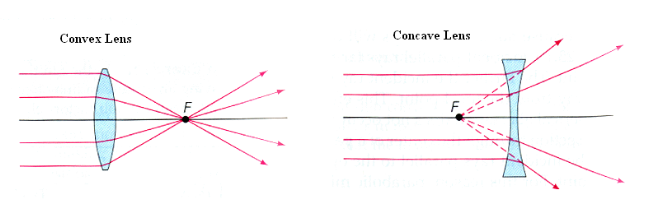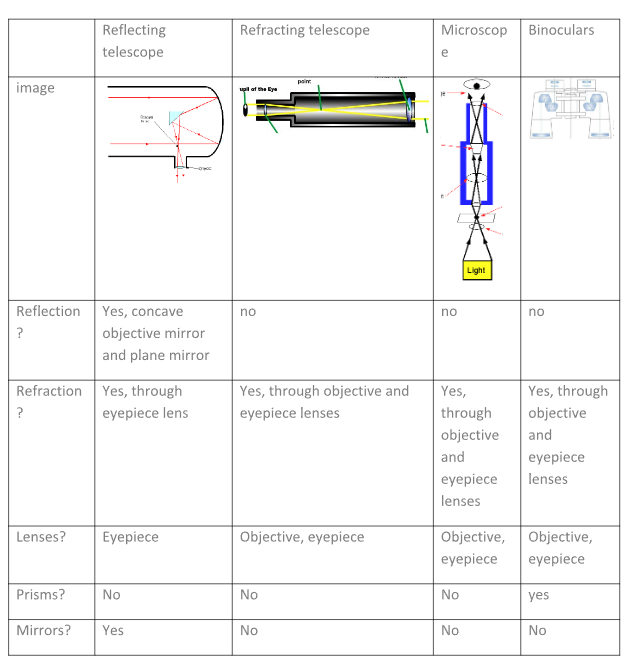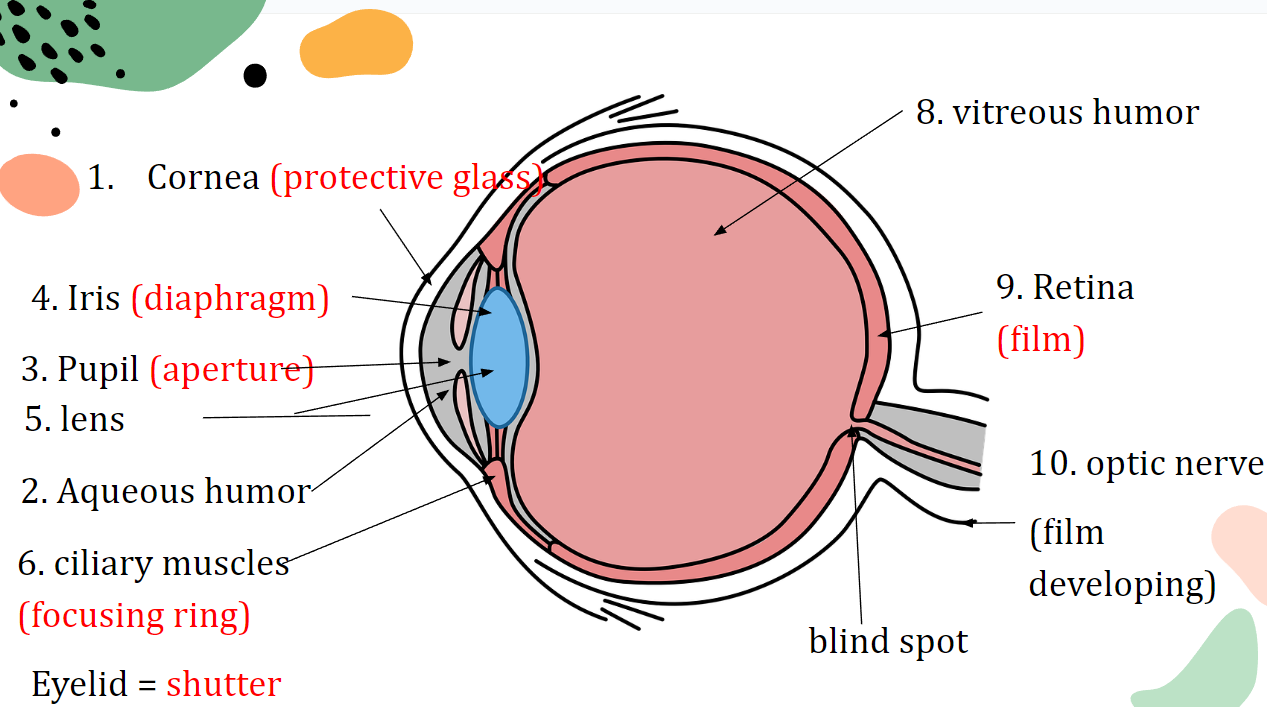
Science 8: Light and Optics LO1, LO2 & LO3
LO1 - Investigate the nature of light and vision and describe the role of invention, explanation, and inquiry in developing our current knowledge.
LO1.1: What are the properties of light, and which scientists contributed to the discovery of these properties?
Scientists who contributed to the discoveries of light properties:
Pythagoras thought that light came from your eyes (this theory was proved wrong).
Euclid discovered the law of reflection.
Ptolemy said that light beams bend (refract).
Al-Haytham showed that light bounces off of objects and then travels to the eye.
Newton showed that white light is made up of all the colours of the rainbow.
These are the six properties of light:
Light travels in waves
Light travels in straight lines
Light can be reflected
Light can bend (or be refracted)
Light is a form of energy
White light is made up of all the colours of the rainbow
LO1.2: How does light interact with different materials?
Translucent:
Lets some light pass through it
Light is transmitted
Examples: Frosted glass, wax paper, cloudy water
Transparent:
Lets the most light through it
Light is transmitted
Examples: Window, seran wrap, clear plastic
Opaque:
Lets no light pass through it
Usually solid
Light is absorbed or reflected
Examples: Blackout curtains, concrete walls, doors, people
LO2 - Investigate the transmission of light and describe its behavior.
LO2.1: What is the law of reflection, and how can we prove it using plane, convex, and concave mirrors?
The Law of Reflection: Euclid developed the theory that we call the Law of Reflection. The law states that light travels in straight lines and reflects from a surface at the same angle at which it hit it.
Another version of the Law of Reflection is: Angle of incidence (i) = Angle of reflection (r)
Concave mirrors: The mirror is curved inwards. Concave mirrors create converging rays, which may create an inverted image (depending on the position away from the focal point). The image may appear magnified.
An example of a concave mirror is a makeup mirror, and lens to correct to near-sightedness.
Convex mirrors: The mirror is curved outwards. Convex mirrors create diverging rays, which create an upright image that appears smaller and further away.
An example of a convex mirror is a car mirror, and lens used to correct far-sightedness. 
LO2.2: What causes refraction and how can we see this in convex and concave lenses?
Refraction: Refraction is the bending of light as it passes from one transparent substance to another. Light bends because it changes speed when it moves between materials with different densities.
The speed of light decreases in more dense materials like glass and water.
The speed of light increases in less dense materials like air.
Lens: A lens is a curved piece of transparent material. It is usually glass or plastic and light refracts as it passes through.
The difference between a mirror and a lens is that mirror reflects and a lens refracts.
Double concave lens: Double concave lenses are DIVERGING lenses, which spread out the light. Light passes through the thicker areas more slowly than in thinner areas. They are used in flashlights and headlights. The image appears smaller and right side up.
Double convex lens: Double convex lenses are CONVERGING lenses, which make the light rays come together. They are used in magnifying glasses, telescopes, and microscopes. The human eye is also a double convex lens. The image forms where rays meet, and it will be inverted. The lens will magnify an object if it is very close to the lens. 
LO3 - Investigate and explain the science of image formation and vision and interpret related technologies.
LO3.1: How is reflection and refraction used in optical devices?
Telescopes: Telescopes help us to see distant objects more clearly. For the best magnification, the distance between the lens and the image should be as big as possible.
Refracting telescope:
Convex objective lens forms the image (collects light)
Convex eyepiece lens magnifies the object
Reflecting telescope:
Objective mirror forms the image (collects light)
Eyepiece lens magnifies the object
Binoculars: Binoculars have two reflecting telescopes side by side. The length of each telescope is shortened by putting prisms inside, and they act like mirrors to reflect the light in a short space.
Microscopes: Microscopes have an objective lens that forms the image. An eyepiece lens magnifies the image even further. 
LO3.2: How does the eye function and how do its parts compare to a camera?
Parts of the eye:
Cornea: The cornea is a thin layer on the surface of the eyeball.
Aqueous humor: Aqueous humour is the watery fluid between the cornea and iris.
Pupil: The pupil is the dark centre of the eye where light comes in, and the size of the pupil is controlled by the iris.
Iris (diaphragm): The iris is the coloured ring of the eye that screens out light. If the light is dim, the iris decreases in size, meaning the pupil will appear larger. If the light is bright, the iris increases in size, meaning the pupil will appear smaller.
Lens: The lens is behind the pupil and the iris. It focuses the eye.
Sclera: The sclera is the outer white coating of the eye.
Ciliary muscle: The ciliary muscle controls the shape of the lens. It contracts to change tension so you can focus on objects near or far.
Vitreous humour: Vitreous humour is the jelly-like fluid behind the lens. It helps keep the shape of the eye.
Retina: The retina is the light-sensitive area at the back of the eye where images focus.
Optic nerve: When the cells in the retina detect light, impulses travel to the brain through the optic nerve.
Blind spot: The blind spot is the point where the optic nerve enters the retina. There are no light-sensing cells in this spot.
Tapetum lucidum: The tapetum lucidum is the tissue that lies behind or within the retina of many animals. It helps to reflect light off of the back of the eye to allow these animals to see in low-light conditions.
Digital cameras: Digital cameras use image sensors to create digital photos. The digital data is processed and saved as images. The resolution of the image is measured in pixels. (Charge-coupled device (CCD))
LO3.3: How do we correct eye problems in the human eye?
Near-sightedness (Myopia):
Can’t see objects far away
Long eyeballs
Images focus in front of the retina
Corrected with concave lenses (- lens)
Image is moved BACK which = focused vision
Far-sightedness (Hyperopia):
Can’t see objects close up
Short eyeballs
Image focuses behind the retina
Corrected with convex lenses (+ lens)
Image is moved FORWARD onto the retina which = focused vision
Astigmatism
Distorted vision caused by a refraction error
Caused by the irregular shape of either the cornea or the lens
Prevents proper focus
Can be corrected with lenses
Science 8: Light and Optics LO1, LO2 & LO3
LO1 - Investigate the nature of light and vision and describe the role of invention, explanation, and inquiry in developing our current knowledge.
LO1.1: What are the properties of light, and which scientists contributed to the discovery of these properties?
Scientists who contributed to the discoveries of light properties:
Pythagoras thought that light came from your eyes (this theory was proved wrong).
Euclid discovered the law of reflection.
Ptolemy said that light beams bend (refract).
Al-Haytham showed that light bounces off of objects and then travels to the eye.
Newton showed that white light is made up of all the colours of the rainbow.
These are the six properties of light:
Light travels in waves
Light travels in straight lines
Light can be reflected
Light can bend (or be refracted)
Light is a form of energy
White light is made up of all the colours of the rainbow
LO1.2: How does light interact with different materials?
Translucent:
Lets some light pass through it
Light is transmitted
Examples: Frosted glass, wax paper, cloudy water
Transparent:
Lets the most light through it
Light is transmitted
Examples: Window, seran wrap, clear plastic
Opaque:
Lets no light pass through it
Usually solid
Light is absorbed or reflected
Examples: Blackout curtains, concrete walls, doors, people
LO2 - Investigate the transmission of light and describe its behavior.
LO2.1: What is the law of reflection, and how can we prove it using plane, convex, and concave mirrors?
The Law of Reflection: Euclid developed the theory that we call the Law of Reflection. The law states that light travels in straight lines and reflects from a surface at the same angle at which it hit it.
Another version of the Law of Reflection is: Angle of incidence (i) = Angle of reflection (r)
Concave mirrors: The mirror is curved inwards. Concave mirrors create converging rays, which may create an inverted image (depending on the position away from the focal point). The image may appear magnified.
An example of a concave mirror is a makeup mirror, and lens to correct to near-sightedness.
Convex mirrors: The mirror is curved outwards. Convex mirrors create diverging rays, which create an upright image that appears smaller and further away.
An example of a convex mirror is a car mirror, and lens used to correct far-sightedness. 
LO2.2: What causes refraction and how can we see this in convex and concave lenses?
Refraction: Refraction is the bending of light as it passes from one transparent substance to another. Light bends because it changes speed when it moves between materials with different densities.
The speed of light decreases in more dense materials like glass and water.
The speed of light increases in less dense materials like air.
Lens: A lens is a curved piece of transparent material. It is usually glass or plastic and light refracts as it passes through.
The difference between a mirror and a lens is that mirror reflects and a lens refracts.
Double concave lens: Double concave lenses are DIVERGING lenses, which spread out the light. Light passes through the thicker areas more slowly than in thinner areas. They are used in flashlights and headlights. The image appears smaller and right side up.
Double convex lens: Double convex lenses are CONVERGING lenses, which make the light rays come together. They are used in magnifying glasses, telescopes, and microscopes. The human eye is also a double convex lens. The image forms where rays meet, and it will be inverted. The lens will magnify an object if it is very close to the lens. 
LO3 - Investigate and explain the science of image formation and vision and interpret related technologies.
LO3.1: How is reflection and refraction used in optical devices?
Telescopes: Telescopes help us to see distant objects more clearly. For the best magnification, the distance between the lens and the image should be as big as possible.
Refracting telescope:
Convex objective lens forms the image (collects light)
Convex eyepiece lens magnifies the object
Reflecting telescope:
Objective mirror forms the image (collects light)
Eyepiece lens magnifies the object
Binoculars: Binoculars have two reflecting telescopes side by side. The length of each telescope is shortened by putting prisms inside, and they act like mirrors to reflect the light in a short space.
Microscopes: Microscopes have an objective lens that forms the image. An eyepiece lens magnifies the image even further. 
LO3.2: How does the eye function and how do its parts compare to a camera?
Parts of the eye:
Cornea: The cornea is a thin layer on the surface of the eyeball.
Aqueous humor: Aqueous humour is the watery fluid between the cornea and iris.
Pupil: The pupil is the dark centre of the eye where light comes in, and the size of the pupil is controlled by the iris.
Iris (diaphragm): The iris is the coloured ring of the eye that screens out light. If the light is dim, the iris decreases in size, meaning the pupil will appear larger. If the light is bright, the iris increases in size, meaning the pupil will appear smaller.
Lens: The lens is behind the pupil and the iris. It focuses the eye.
Sclera: The sclera is the outer white coating of the eye.
Ciliary muscle: The ciliary muscle controls the shape of the lens. It contracts to change tension so you can focus on objects near or far.
Vitreous humour: Vitreous humour is the jelly-like fluid behind the lens. It helps keep the shape of the eye.
Retina: The retina is the light-sensitive area at the back of the eye where images focus.
Optic nerve: When the cells in the retina detect light, impulses travel to the brain through the optic nerve.
Blind spot: The blind spot is the point where the optic nerve enters the retina. There are no light-sensing cells in this spot.
Tapetum lucidum: The tapetum lucidum is the tissue that lies behind or within the retina of many animals. It helps to reflect light off of the back of the eye to allow these animals to see in low-light conditions.
Digital cameras: Digital cameras use image sensors to create digital photos. The digital data is processed and saved as images. The resolution of the image is measured in pixels. (Charge-coupled device (CCD))
LO3.3: How do we correct eye problems in the human eye?
Near-sightedness (Myopia):
Can’t see objects far away
Long eyeballs
Images focus in front of the retina
Corrected with concave lenses (- lens)
Image is moved BACK which = focused vision
Far-sightedness (Hyperopia):
Can’t see objects close up
Short eyeballs
Image focuses behind the retina
Corrected with convex lenses (+ lens)
Image is moved FORWARD onto the retina which = focused vision
Astigmatism
Distorted vision caused by a refraction error
Caused by the irregular shape of either the cornea or the lens
Prevents proper focus
Can be corrected with lenses
 Knowt
Knowt